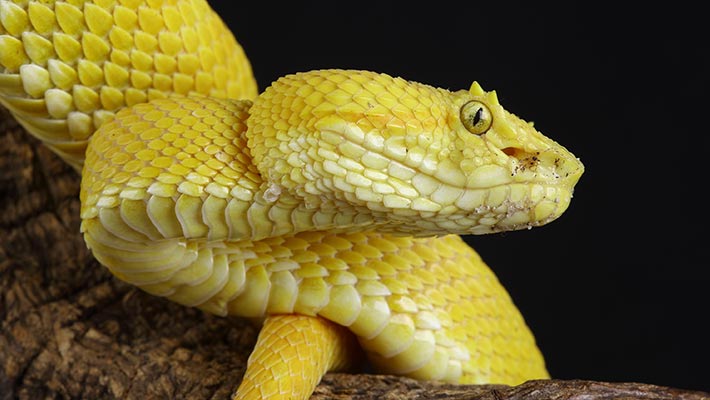Learn about Central American Eyelash Vipers
Scientific name: Bothriechis nigroadspersus
Conservation status: Threatened
Habitat: Moist tropical forests and rainforests. Streamside vegetation in moist lowlands and mountain foothills to high-elevation montane and cloud forests.
Distribution: Central America - Costa Rica and Panama
Size: Females = 35 to 82 cm. Males = 37 to 69 cm.
Weight: 225g
Lifespan: Wild = 6-10 years. Captivity = 10-20 years
Diet: Carnivore – small rodents, frogs, lizards, and small birds.
Reproduction: 6 months incubation. 2 to 20 young born live
Care for young: Hatchlings are fully self-sufficient
Environmental threats: Habitat destruction – agriculture & urbanisation. Poaching & Illegal Pet Trade. Climate Change.
Finding five
In 2024 a significant discovery revealed that there was not one species of eyelash viper but in fact five species of these spectacularly coloured snakes. New species are always a big deal, and doubly so when the animals in question come in all the colours of the rainbow. The discovery of five genetically distinct species of eyelash vipers and their undescribed diversity is an important example illustrating just how much of the planet’s biodiversity remains to be discovered.
Scent of a snake
Sense of smell is an important aspect of mate selection in vipers. When courting females, males compete in a ritual called “the dance of the adders.” They face each other with the front of their bodies erect and attempt to knock each other down. No biting occurs. The ritual can go on for hours before one male is victorious.
Ovoviviparous? What ’Tha?
Female eyelash vipers incubate eggs internally for an approximately six-month gestation period and often stop feeding in the final stages of pregnancy. Eyelash pit vipers are ovoviviparous, meaning that after gestation, the young hatch out of their egg membrane inside the mother’s body or immediately after birth of the egg. These vipers typically bear 2 to 20 live young per brood.
This is bananas!
Because of their relatively small size and ability to become camouflaged among bright yellow fruit, yellow Central American Eyelash Vipers have been accidentally shipped throughout the world in boxes of bananas.
Cryptic Critter
Variation of ones’ scales matter when your markings, coloration, shapes, and fake lashes help you to survive in the wild being difficult to see or otherwise detect. Camouflaged in its natural environment, up high, is a huge asset when these slow-moving pit vipers rely on ambushing their prey.
Fright night
Central American Eyelash Vipers are nocturnal predators, although they also capture moving prey from the safety of their daytime [diurnal] perch. After capture, they paralyse their prey by injecting hemotoxic venom (toxins capable of destroying red blood cells). This venom affects both the central nervous system and the cardiovascular system, making it highly toxic.
